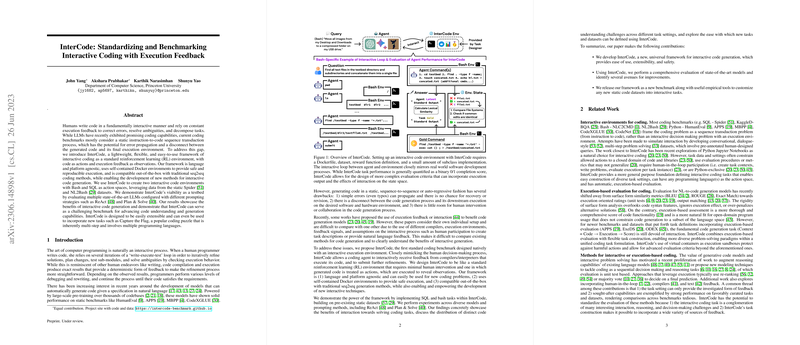Overview of "InterCode: Standardizing and Benchmarking Interactive Coding with Execution Feedback"
The paper "InterCode: Standardizing and Benchmarking Interactive Coding with Execution Feedback" presents a significant stride towards enhancing the coding capabilities of LLMs by integrating interactivity and execution feedback into the code generation process. This paper addressses the limitations of current code generation benchmarks, which typically evaluate models on static, instruction-to-code sequence transduction that excludes the iterative and feedback-driven nature of human coding practices.
Contributions and Framework
The primary contribution is the introduction of the InterCode framework, positioned as a reinforcement learning (RL) environment where code actions are paired with execution feedback observations. Designed to be lightweight and flexible, InterCode supports various programming languages—demonstrated with environments for Bash, SQL, and Python—and is compatible with seq2seq methods along with facilitating novel interactive code generation approaches.
InterCode stands out for its versatility and extensibility. Built on Docker, it offers language and platform agnosticism, a safe execution space, and ease of customization. This is particularly advantageous for creating reproducible interactive benchmarks or incorporating new languages and datasets.
Experimental Evaluation and Results
The paper demonstrates InterCode's practicality by creating environments for Bash, SQL, and Python tasks using data from established datasets (NL2Bash, Spider, MBPP). In evaluating InterCode, several prompting strategies are tested on state-of-the-art models such as OpenAI's GPT-3.5, GPT-4, Google's PaLM models, and Vicuna among others.
The results reveal the efficacy of interactive coding over static approaches, with noticeable improvements in the success rate of task completion. Specifically, the paper highlights that prompting strategies like ReAct and Plan {content} Solve show enhanced model performance due to their structure that mimics human reasoning processes. Notably, GPT-4 exhibited a success rate increase on SQL tasks from 9.1% to 73.7% when interacting was allowed, emphasizing the stark contrast in performance between interactive and static evaluation paradigms.
Theoretical and Practical Implications
Theoretically, this paper underscores the potential of RL and interactive feedback to bridge the gap between generated code and its operational context. By aligning model evaluation with real-world coding practices, InterCode provides a more granular understanding of a model's coding capabilities and shortcomings.
Practically, incorporating interaction and execution feedback can significantly advance the development of AI systems capable of accurate and context-aware code generation, making them suitable for more complex applications in software engineering and data science.
Future Prospects
The research paves the way for further exploration into more adaptive and nuanced interactive coding benchmarks. The authors suggest expanding InterCode to include additional programming languages and more complex tasks like Capture the Flag challenges, which integrate multi-language requirements.
The introduction of InterCode marks a methodological shift towards a holistic view of code generation tasks, encouraging the development of LLMs that can iteratively refine their outputs through feedback, closely resembling human programmers' workflows.
In summary, the paper offers a robust framework and benchmark—InterCode—that lays the groundwork for improved interactive coding methods, shedding light on the significant benefits of merging RL-based environments with LLMs in the field of code generation.
